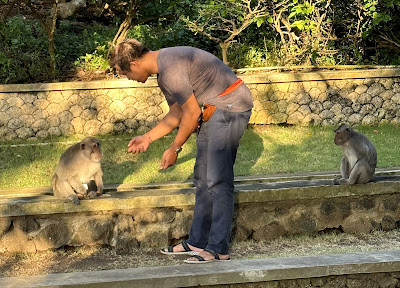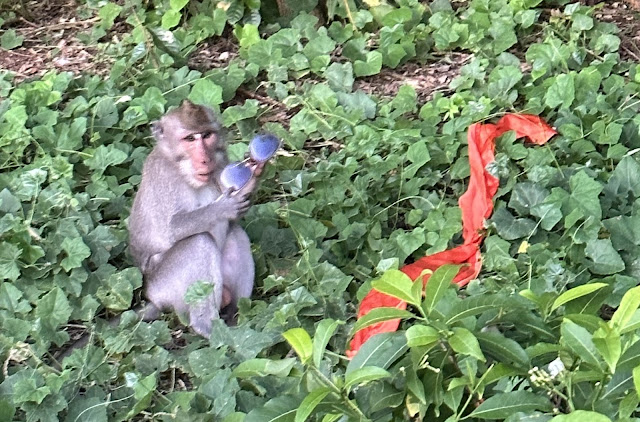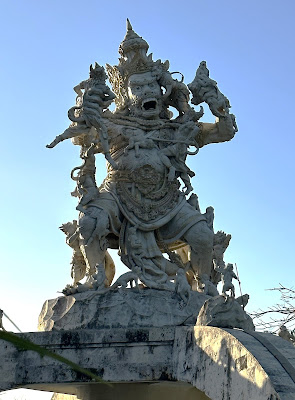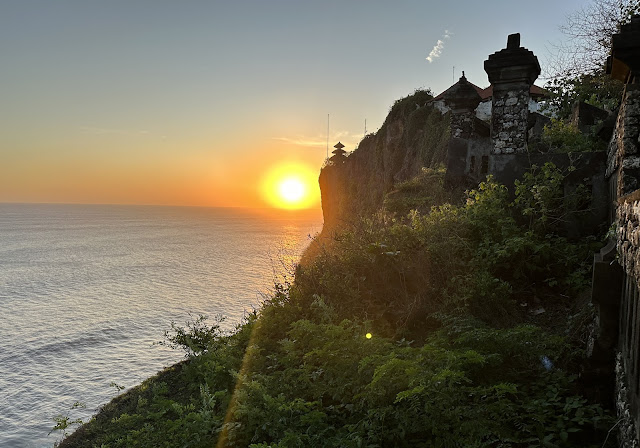July 10, 2023
We drove the last 20 minutes to Uluwatu Temple, which was (surprise!) quite crowded.
A sign at the entrance to one of the temples noted that women who are menstruating are not allowed inside. I didn't know Hindus had this dogma of "unclean" women. Women have it rough everywhere.
The water bottle trick was cute, but the monkeys are known for stealing glasses, hats, pens, and whatever they can get their hands on. Special employees (identifiable by their uniforms) are called to get the pilfered item back from the thief if the guest can't. The park employees throw the monkey a banana or another treat, and the monkey drops the stolen item. The monkeys have learned to barter, and they pass their skills down through the generations. They will hang on to a stolen item and wait for the guy with the treat to show up.
We saw one monkey with someone's cell phone. He had actually gotten the case off the phone. The owner tried to get it back, but he didn't have the right bartering material.
Luckily, the park employee was able to get the phone back before damage was done.
I saw a monkey steal sunglasses from a girl right in front of me. She had them tucked in her sash, but the monkey was on them so fast that she didn't have time to react. Crazy!
We watched another monkey poke the lenses out of a pair of sunglasses before anyone could stop him.
Bob himself was a near victim. He had his phone in his shirt pocket and was leaning on a wall and gazing at the ocean. Another guest warned him there was a monkey just over his shoulder and getting ready to pounce.
We took a lot of photos of the monkeys, but there were also some really interesting statues, stonework, and buildings.
This is Kumbharkarna, a mythical Hindu creature said to have immense strength and a massive appetite.
Still recovering from his three days of fever, Bob wore out pretty fast, so Ayu and I left him resting under a covered pavilion and went for a walk on a path on the edge of a cliff.
The sun was sinking slowly towards the horizon, and the light was both serene and eerie. It wasn't this dark, but looking towards the west made the sun dominant and everything else shadowed in my photos.
We made our way back to Bob, who said that while he was waiting for us, he saw two of the guards go after the naughty monkeys with slingshots!
When it was almost dark, we got in line for a "cultural performance" in a large arena, something we were kind of dreading, having seen many boring dance presentations in other foreign countries. However, this hour-long performance was one of the best we've seen.
This performance, called a kecak, is a dance and music drama developed in Indonesia in the 1930s. It is based on the Sanskrit epic tale Ramayana and is performed in Balinese temples and villages. A "choir" of about 50 men clad only in black, white, and red loin cloths (or maybe shorts?) provides oral percussion that serves as the background "music"--a repetitive, rhythmic chanting of "chak-a-chak-a-chak." The chanters constantly wave their arms and shake their hands. The speed and intensity of their chanting creates the mood of the story.
When it was over, people poured out of the arena and to the parking lot. Somehow, our guide found us as we came out, but it took us about 20 minutes to find our driver and car.
It was 9:30 by the time we got to our Novotel Hotel--a really beautiful place that we didn't have time to enjoy. We paid about $15-18 each for a box breakfast for the morning, and then crashed in our room.













































I was surprised that I enjoyed the night show. I usually don't. It had lots of humor and was well done. Otherwise, the monkeys are the stars of the temple. They run the show.
ReplyDelete